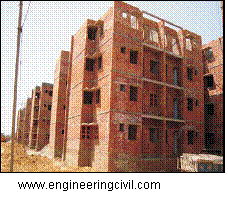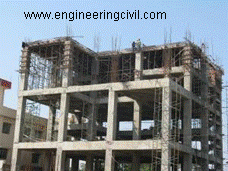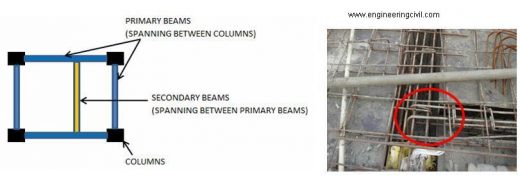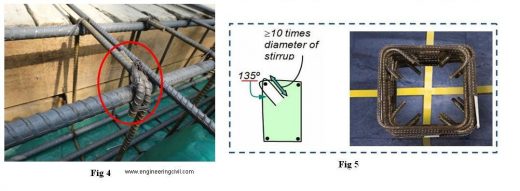By
Sourav Dutta
Manager-Civil
There are a number of ways in which the superstructure can be built. In areas where average to good quality bricks are available, the walls of houses for two to three storeyed constructions can be built out of bricks with the slabs, lintels, chajja etc. in reinforced concrete. Such construction is supported entirely on load bearing brick walls (Fig 1), foundation of which ultimately transfers the building load to underneath soil.

Fig 1: Load Bearing Construction on brick

Fig 2: RCC framed construction
With natural hazards like earthquake or high speed storms hitting various parts of country more frequently, such load bearing wall construction are no longer safe for withstanding horizontal drifts unless retrofitted. Also such construction is suitable upto G+2 storied building in general.
With high storied construction trend now-a-days coupled with natural hazards, it is advisable to opt for RCC (Reinforced Cement Concrete) framed construction (Fig 2). Basically, RCC framed construction consists of a series of columns provided suitably in the house which are interconnected by beams to form a frame.The beams carry the load from slab/building and transfer to columns, and therefrom the building load is transferred to underneath soil through RCC footings.Beams span between one or more supports, and are reinforced by means of main longitudinal bars to resist bending moment; and transverse steel (closed ties) to resist shear force.
Beams are meant for supporting load of brick walls also (slab couldn’t carry brick wall load in general), hence width of beams shouldn’t be less than width of walls. In general, beams have minimum width of 230 to 250 mm.
Typical Loads to be considered for Beam Design
(i) Dead Load: Any permanent load acting on the beam, e.g. self-weight of beam, dead load/super-imposed dead load of slab/staircase, weight of brick wall.
(ii) Live Load: Any non-permanent or moving load on slab.
(iii) Earthquake Load: Depends on the seismic zone where building is located, also upon dead weight (seismic weight) of building, soil site type.
(iv) Wind Load: Depends upon the wind speed, height & location of building. Also terrain and adjacent structures play a role in determination of this load.
Beam Design & Construction: Busting Myth
| Sl No | Myth | Actual |
| 1 | Bottom reinforcement of beam should always be more than top reinforcement | Bending moments at supports of continuous beams of framed structure are almost 1.75 to 2 times higher than span moments in dead load + live load case only. Now considering wind load, seismic load cases, and load combinations, the bending moments at support top are further enhanced. Hence steel reinforcement requirement at support tops are always higher compared to requirement at span bottom. |
| 2 | 6 mm rings/ties are too thin to hold the beamrebars | Use of 6 mm rings is allowed as perpresent BIS guidelines and makes no difference to the structural stability of beam, provided it is made and fixed as per BIS guidelines. It also results in significant savings over 8 mm rings. |
| 3 | Rings can be placed at a standard spacing (150/200 mm c/c) throughout in the beam | As per the guidelines of BIS 13920(a), rings should be placed at closer distance (about 4’’)upto 2d distance [d=effective depth of beam] from any beam-column joint. The spacing in the balancecentral part of beam can be 5’’ to 6’’, based on actual calculation. |
| 4 | At beam-column junction, beam rebar can be made to pass through inside/outside of column rebar, makes no difference | The load transfer occurs from beam to column. Hence it is entirely necessary that the beam rebar is tied with column rebar using binding wires, which is the medium of load transfer. Now, if the same is not tied properly, no load transfer would be occurring to columns, and column is totally ineffective. If beam rebar passes through inside of column rebar, and such case happens, at least partial load may be expected to be transferred to column, as well as the beam bars wont have any freedom to shift off, as it will be surrounded by column bars. |
| 5 | At beam-column junction, beam rebar to be bend and made to pass through column rebar | Beam rebars are meant to carry axial tensile forces arising from bending moment on the section. The portion where the beam rebar is bent at an angle, the rebar becomes ineffective to carry tensile force. |
Recommended construction practices for beams
1. Secondary beam rebar should be placed above primary beam rebar (fig 3), as the load coming on secondary beam is transferred to primary beam and thereby to columns.

Fig 3: Secondary beam reinforcement should be supported above primary beam reinforcement
2. The ends of the ties must be bent as 135°hooks. The length of bend must be at least 10 times diameter of steel bar or75 mm. Such configuration is mandatory as per BIS 13920(a) for earthquake zones III, IV and V in India. Fig 4 shows the wrong practise and fig 5 shows the correct oneas per BIS 13920(a).
(a) BIS 13920 is the code of practise pertaining to ductile detailing for RCC structures
We at engineeringcivil.com are thankful to Er. Sourav Dutta for submitting this paper to us. We hope this paper will be helpful for the whole construction industry in general.
If you have a query, you can ask a question here.




thanks
please recommend clear solution for myth no. 5 and position for beam rebar at beam column junction. (which should be outer – beam bars or column bars)
column bars
beam bars should pass inside the column bars ( strong column, weak beam model )